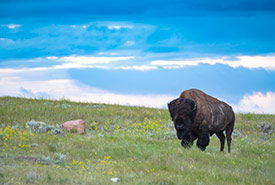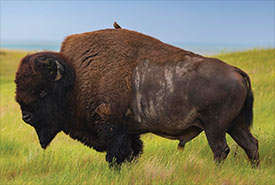Wallowing: More than scratching an itch for plains bison

Bison at Old Man on His Back Prairie and Heritage Conservation Area (Photo by Jason Bantle)
Have you ever had an itch that you just couldn’t scratch? Needed to cool down on a hot summer day in the Prairies? Want a new way to show off to the ladies? If you answered yes to any of these questions, have you tried simply rolling around in the dirt?
For thousands of years, bison have been using this technique, known as wallowing, to accomplish all of these feats and more.
On a recent trip to the Nature Conservancy of Canada’s (NCC’s) Old Man on His Back Prairie and Heritage Conservation Area (OMB) in southwest Saskatchewan, a few of my fellow colleagues and I were fortunate enough to observe one of the old bison bulls wallowing while on our way back to the visitor’s centre. It may seem as if watching a 900-kilogram animal rolling around on the ground would be quite comical, but in reality, it was fascinating to witness this behaviour.
Wallowing helps bison in many ways. These dust baths allow them to scratch insect bites, get rid of their thick winter coats so they can cool down and get away from the hot grass on the surrounding prairie landscape. Additionally, covering themselves in dirt helps bison create a protective layer against parasites, such as ticks or lice, that can become problematic over time, even to an animal of their size.
During mating season, bison bulls also use wallows to assert their dominance over other males by urinating in the dirt before rolling in it so that their scent remains on the landscape. In turn, any female that wallows at the same site becomes marked with that bulls scent as a way for the males to mark their territory.
You may have come across a wallowing site without even realizing it! Such a heavy animal rolling on the ground compacts the soil and creates a bowl-shaped depression that is about three metres in diameter. While the thought of many barren patches of dirt may appear to fragment the landscape, wallows play an important role in promoting the biodiversity of prairie ecosystems.

Bison at OMB, SK (Photo by Jason Bantle)
Wallows are what the scientific community would consider a natural disturbance to the land, meaning that if humans were not around to disturb anything, disturbances would still occur, much like natural forest fires or a river cutting a new bank. Disturbing the land allows plants that may have been struggling to compete for sunlight and nutrients in a dense area to thrive, while also giving what are called pioneer species the room to establish themselves. Pioneer species are the first organisms to establish on a new or recently disturbed site as they are highly adaptable and have the ability to grow in extremely poor conditions. They are crucial to the environment, as they develop the site so that it is usable to other plants and animals. Some common pioneer plants you would find in an old bison wallow include common yarrow, silverweed and wild strawberry.
Plants are not the only organisms that benefit from wallows; the bowl-like shape has been known to catch and hold water more easily than the flat, vegetated areas around them, creating valuable microhabitats on the landscape for aquatic insects and amphibians. Having a high number of different plant and animal species throughout the Prairies is a huge benefit to these resilient ecosystems. Who would have thought that a bison scratching its back could help promote the health of the entire habitat!
Although only domesticated bison exist on the prairie today, the presence of ancient wild herds can still be found on the land. Wallows that are hundreds of years old may not look like the barren soil bowls that were just described above; instead, the unique plants and animals that wallows attract often have a different colour and texture than the organisms in the surrounding area, making them distinctly noticeable throughout the landscape. So, the next time you’re walking, driving or even flying across the Prairies, watch for these unique areas and be sure to think of the bison that created them.
Want to support wildlife species and their habitat? With your donation, you are accelerating the pace of conservation and helping find solutions to the twin crises of rapid biodiversity decline and climate change. Learn more >


